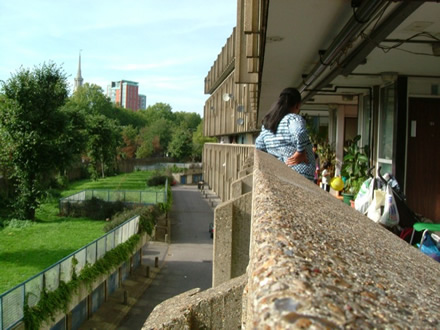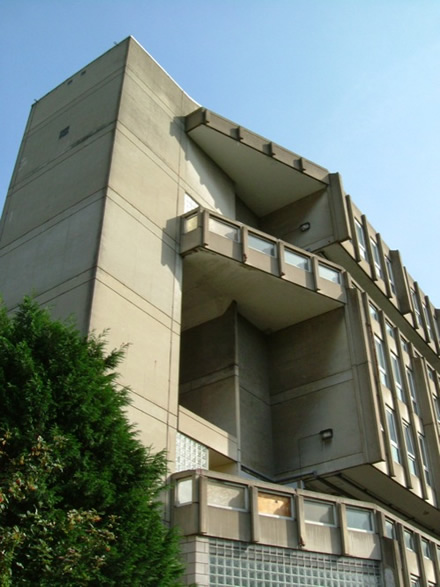
(images by Flickr user moreikura)
Robin Hood Gardens, like Euston Arch before it, will take its secret to its grave.
Last week, 'architecture minister' Margaret Hodge sounded the death knell for Robin Hood Gardens when she decided not to list the building, following the advice of English Heritage (described as a "beleagured quango" by the Twentieth Century Society) but ignoring the protestations of many within the architectural profession, including Richard Rogers, Norman Foster and Zaha Hadid, and an ongoing campaign by Building Design magazine.

As the future of Robin Hood Gardens hung in the balance, debate has raged, both in the broadsheet press, and the 'blogosphere', both of the merits of RHG and Brutalist architecture, but also the wider debate about preservation, restoration and resurrection of modern buildings, seemingly only loved by architects themselves.
Reaction to starchitects attempting to defend RHG is generally of the level of "well if you like it, why don't you live there." - see here or here. You might expect the quality press to avoid this school playground rhetoric, but we have the "why don't they buy it and mend it themselves" from Simon Jenkins in the Guardian, and this rip-snorter from Venetia Thompson in The Spectator:
"Robin Hood famously robbed from the rich to give to the poor, but I am certain that he never suggested that the poor should then be crammed into tower blocks like battery chickens in the name of Modernist architecture until they were finally stabbed to death in a deserted stairwell. There is nothing truly egalitarian about the ironically named Robin Hood Gardens in Poplar, east London — except the equality of squalor.
However - wouldn't you know it? - Modernist architects are campaigning to save it. Zaha Hadid describes it as ‘a seminal project of socially responsible architecture from the era of Utopian thinking'. Maybe she should go and live there herself. This is a prime example of the desire for impractical ‘modernity' getting in the way of common sense and human well-being."
Is Robin Hood Gardens really "not fit for purpose", as Margaret Hodge's report concludes? It's one of those horrible phrases, like "EPIC FAIL" or "broke by design" whereby an individual's subjective opinion is presented as immutable objective fact. There's little doubting that RHG is currently not fit for its residents to live in, but this is a scandal that has been ongoing for many years. Poorly maintained, and filled with vulnerable families from the poorest socio-economic backgrounds, it seems that only now are residents being asked what they think of it.
From what I have read, most of their complaints are about building maintainence issues, and overcrowding. That the roofs leak, there are rats, and that large families are living in 2 bedroom flats, are hardly the result of poor design by the Smithsons, of architectural ideology taking precedent over the well-being of its residents. Instead they are symptoms of wayward social housing policies by Tower Hamlets council and central government.
As this article states, some residents are worried about where they will be rehoused:
'Resident Masum Ali:
"I've lived here since 2001 and I've never had a complaint about the place. But I've never seen the council do any repairs or painting.
People want to stay here and they want to remain with the council. We're tenants of the council, not English Partnerships or a registered social landlord. The places we've been shown in Bow are very small and you can almost touch the roof.
I've spent money on this house and I want to stay here. It's very quiet and we've got a nice community. It feels like we're being ignored.”"
The article claims that tenants 150 of the 214 units have asked to remain with the council rather than come off the council list and transfer to a social landlord (ie private management company) or an Arms Length Management Organisation (ie private management company).
'Firuz Mirh has been living on the estate for 10 years, and is worried about possible price increases.
He said: “It was a nice place to live, but it's not any more.
"The Blackwall Tunnel is getting busier and there's a lot more pollution. And the building is getting old and there are a lot of cracks appearing.
People moved into these houses with one or two children, and they're still there with three, four or five because they can't afford anything bigger.
A lot of people are asking why the council can't run the new development. They're worried they won't be able to afford to live if the prices go up, especially when you include the gas and electric bills. People are just struggling to survive."'
There is real luxury at Robin Hood Gardens. But it is a luxury of material, of light and of space, both public and private. The flats themselves are well designed and generously proportioned, the density across the site is not that high (only 214 units), and there is a chronically underused open space between the two slab blocks. But it's hard to appreciate this when the lights in the stairwells don't work and there's water coming in.
Spend some time in an around Robin Hood Gardens, and it reveals that rather than being the squalid, desolate crime-ridden ghetto some would lead you to believe, it's actually a rather pleasant place. Rather than a high-rise, densely packed estate, RHG is actually the smallest, greenest part of the local urban fabric, human in scale. But springing up around are looming apartment blocks, with all the trimmings and trappings of upmarket chic London living, only minutes from Canary Wharf.
The demolition of RHG is about greed. A quick look at the Blackwall Reach website shows the plan for English Partnerships to 'regenerate' the area and add about 3000 housing units over the site of Robin Hood Gardens and surrounding area.
The website rather cunningly suggests that it is not possible to build this number of new houses, and generate money to create supporting community facilities, while preserving Robin Hood Gardens. This is specious nonsense, a manipulation of facts to manufacture consent. Unsurprisingly, the list of 'disadvantages' of regeneration while preserving the RHG estate is much longer than the list of 'advantages'. (This point also picked up here).
Robin Hood Gardens could be brought up to scratch for approx £70K per flat, considerably less than the cost of building new. But building new will allow building taller, building higher density, and building into the green space at the heart of the estate.
Regardless of what you think of the architectural merits of Robin Hood Gardens, they will not be knocked down because they are "not fit for purpose", but to fund development.
That Robin Hood Gardens is actually a pair of luxury designer apartment blocks, masquerading as a sink housing estate, is a secret that will only be revealed after it is demolished.
Previously:
